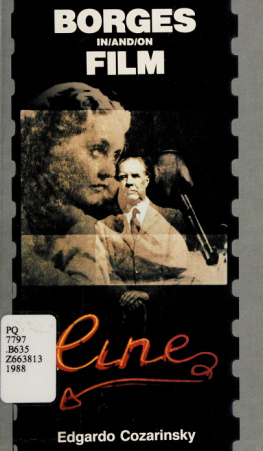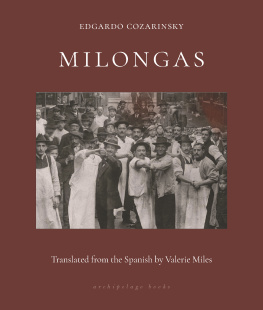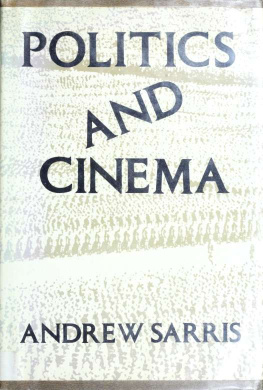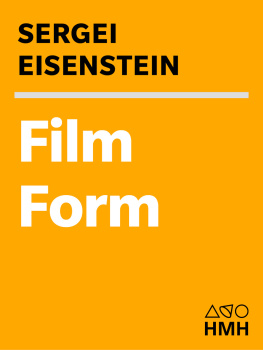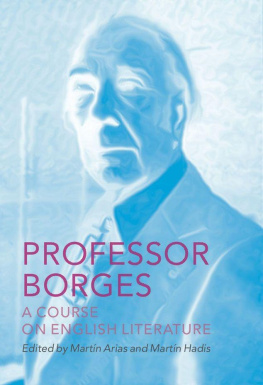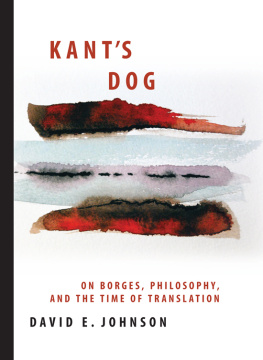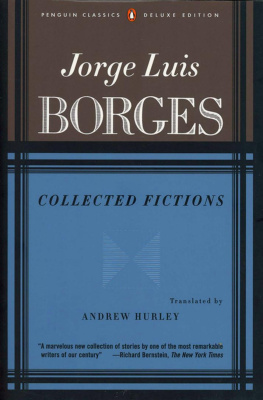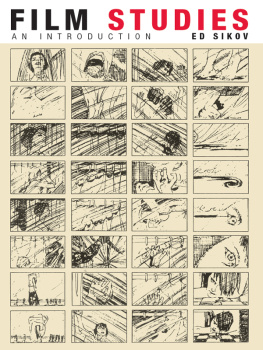
Borges in/and/on film
Cozarinsky, Edgardo
This book was produced in EPUB format by the Internet Archive.
The book pages were scanned and converted to EPUB format automatically. This process relies on optical character recognition, and is somewhat susceptible to errors. The book may not offer the correct reading sequence, and there may be weird characters, non-words, and incorrect guesses at structure. Some page numbers and headers or footers may remain from the scanned page. The process which identifies images might have found stray marks on the page which are not actually images from the book. The hidden page numbering which may be available to your ereader corresponds to the numbered pages in the print edition, but is not an exact match; page numbers will increment at the same rate as the corresponding print edition, but we may have started numbering before the print book's visible page numbers. The Internet Archive is working to improve the scanning process and resulting books, but in the meantime, we hope that this book will be useful to you.
The Internet Archive was founded in 1996 to build an Internet library and to promote universal access to all knowledge. The Archive's purposes include offering permanent access for researchers, historians, scholars, people with disabilities, and the general public to historical collections that exist in digital format. The Internet Archive includes texts, audio, moving images, and software as well as archived web pages, and provides specialized services for information access for the blind and other persons with disabilities.
Created with abbyy2epub (v.1.7.2)
Nunc Cognosco Ex Parte
TRENT
^ UNIVERSITY
Thomas J. Bata Library
PRESENTED IN MEMORY OF
EDWIN WILLIAM CURTIN &
IRENE ELIZABETH CURTIN
Digitized by the Internet Archive in 2019 with funding from Kahle/Austin Foundation
https://archive.org/details/borgesinandonfilOOOOcoza
BORGES IN/AND/ON FILM
Edgardo Cozarinsky
BORGES IN/AND/ON FILM
___S t T Y
L I BR A R Y
PETERBOROUGH, ONTARIO
Translated by Gloria Waldman and Ronald Christ
Lumen Books
Excerpts from this translation have appeared, in different form, in the magazines Sight and Sound, October, Nimrod, and SITES, as well as in Argentine Cinema (Toronto, 1986).
1988 Lumen Inc. Translation 1988 Ronald Christ, world rights in English reserved.
ISBN 0-930829-08-5
Lumen Books are produced by Lumen Inc., a tax-exempt, nonprofit organization. This publication is made possible, in part, with public funds from the New York State Council on the Arts, the National Endowment for the Arts, and with private contributions.
Lumen Books 446 West 20 Street New York, NY 10011
Published in Spain as Borges en/y/sobre cine. 1980 Edgardo Cozarinsky. 1981 Editorial Fundamentos.
Contents
Prologue by Adolfo Bioy-Casares. 1
Foreword by Edgardo Cozarinsky. 3
A Note on the Translation. 5
Partial Enchantments of Narrative. 9
Borges on Film
Reviews
FILMS (Der Morder Dimitri Karamasoff,
City Lights, Morocco).23
STREET SCENE.27
THE INFORMER.30
TWO FILMS (Crime and Punishment,
The Thirty-nine Steps).33
THE PETRIFIED FOREST.35
WELLS THE VISIONARY (Things to Come).37
FILM AND THEATRE.40
TWO FILMS (Sabotage, Los muchachos
de antes no usaban gomina).44
LA FUG A.47
GREEN PASTURES.49
THE ROAD BACK.51
PRISIONEROS DE LA TIERRA.53
AN OVERWHELMING FILM (Citizen Kane).55
DR. JEKYLL AND MR. HYDE TRANSFORMED ... 57
TWO FILMS (Now Voyager, Nightmare).59
ON DUBBING.62
FIVE BRIEF ITEMS.65
A Prologue.69
Two Synopses of Films.22
Film on Borges
Adventures of the Text
A Source for Exegetes.77
A Source for Cineastes.87
Versions and Perversions.93
Prologue
As enjoyable as it is useful, this admirable book presented to us by Edgardo Cozarinsky brings back memories of the earliest years of my friendship with Borges. In those days, we used to talk a lot about books and films (with a special bias for the plots: plots of novels, short stories, films, and even poems, such as those by Victor Hugo and Robert Browning). Film was always an important art for Borges. I would venture to say that if he had composed a list of the works that moved him most at the time, we would find more than a few films included. Nevertheless, he once said to me: At the movies, were all readers of Madame Delly.' If that assertion implied a certain reservation, Borgess enthusiasm for films was unbridled by it. At its worst, the remark might be interpreted as a judgment on the films already made, not the ones still possible. But I take the remark essentially as an indication of Borgess capacity to see things quickly in a new, unexpected, and realistic way, as well as of his capacity for turning himself, at any moment, into a sort of devils advocate.
Perhaps at this point I should quote a young fellows remark that I once overheard in a bookstore on the Boulevard Saint Michel: Borgess opinions annoy me twice over. First, when I find them arbitrary; second, when I find them right.
Adolfo Bioy-Casares
'Pen-name of Mane (1875-1947) and Frederic (1876-1949) Petitjean de la Rosiere sister and brother whose romantic fiction was immensely popular with female readers in the first half of this century. Starting with Une femme supeneure in 1907, some hundred titles had appeared under their common signature by 1941. Dellvs popularity was extraordinary throughout Latin Amenca, and t e novels are regarded as the main influence on Conn Tellado. In France today, pocket reprints of the books run to 100,000 copies.
Foreword
In 1935, when he published the original prologue to his Universal History of Infamy, Borges admitted that his first exercises in fiction derived from the films of von Sternberg. In 1940, when he published his Anthology of Fantastic Literature (compiled with Adolfo Bioy-Casares and Silvina Ocampo and serving as a nondiscursive manifesto, proceeding by example, for the literary choices illustrated by their later work), one of the seven lines giving information about Borges announced: He writes, in vain, scripts for films...
Borgess relationship with film has been as labyrinthine and surprising as his characters relation to time, and this book attempts to inventory, on a necessarily provisional basis, the numerous, even contradictory aspects of that relationship. Consequently, the central section comprises those reviews of individual films as well as the essays on various aspects of cinematographic language that Borges published in the Argentine literary magazine SUR between 1931 and 1944. These reviews, however, are merely the most explicit among many references to film scattered throughout Borgess splendidly fragmentary and only seemingly discontinuous text-to use that term, since he disdained the label oeuvre. In that reiterating text, one can recognize not only a series of attitudes toward film, but also ideas on all narrative practice, options dramatized in the writing of a story and already implicit in Borgess treatment of movies. Such a recognition is what I have attempted in my introductory essay. In the last section of the book, I track downwith less erudition than humor, and greater curiosity about the unpredictable results than any qualms about fidelityBorgess almost parodic impact on critics and filmmakers (sometimes one and the same person) who have quoted him, and on the films that have adapted his stones and interpreted his original plots for movies. Predictably, the resulting book incorporates all these materials in a nonlinear fashion, respecting, instead, their diversity and allowing them to radiate in
Next page
